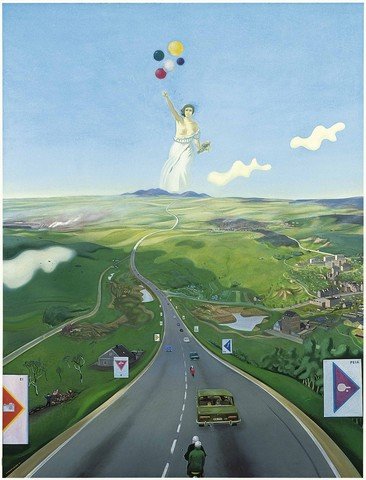Bildquelle:
Wolfgang Mattheuer, Hinter den sieben Bergen, 1973, VG Bild-Kunst Bonn, 2022
https://mdbk.de/ausstellungen/bilderkosmos-leipzig-1905-2022/
Leipzig: A Universe of Images. 1905-2022
Current exhibition
Museum der bildenden Künste Leipzig
https://mdbk.de/en/exhibitions/bilderkosmos-leipzig-1905-2022/
“The exhibition Leipzig: A Universe of Images. 1905-2022 presents more than 200 works, some well-known and others still unknown. […] Visitors are guided through the development of modern art in Leipzig over the last century up to the present day on the almost complete area of the third floor. […] From expressive painting strategies or sober-looking fine painting to abstract and ironic-naïve attitudes of contemporary art, visitors can experience the diversity of Leipzig art in the exhibition.”
Unter dem Radar. Originalgrafische Kunstplakate aus Ostdeutschland seit 1975
(Below the radar. Original-graphic art posters from East Germany since 1975)
Current exhibition until April, 18 2022
Museum für Druckkunst Leipzig
https://www.druckkunst-museum.de/en/event/unter-dem-radar-2.html
“Based on around 100 original graphic art posters from the collection of the Galerie am Sachsenplatz, supplemented by other items on loan, the museum gives an insight into countercultural initiatives and free spaces of art in East Germany. On the one hand, the show focuses on artists who were mainly active in printmaking in the GDR. These include Angela Hampel, Michael Morgner, Max Uhlig and the Clara Mosch group. On the other hand, the posters present less well-known art locations and the lively, non-state-controlled exhibition system in East Germany from Ahrenshoop to Zwickau.”
Offener Prozess
(Open Process – title is linked to the reappraisal of the NSU complex)
Current exhibition
Galerie für zeitgenössische Kunst Leipzig
https://gfzk.de/en/2022/deoffener-prozess-nsu-aufarbeitung-in-sachsen/
“The exhibition “Offener Prozess” addresses the question of the NSU complex. Taking East German reality, particularly in Saxony, as its starting point, it tells a story of the NSU complex that begins with migration histories and continual right-wing and racist violence, along with the resistance shown against it. It uses a “living memory” approach, which brings marginalised perspectives into focus. It also examines structural and institutional racism.”
Leipzig 1813
Current exhibition
Panometer Leipzig
https://www.panometer.de/en/leipzig/our-exhibitions#
“On a 3,500 square-metre surface, the scenery of Leipzig unfolds in the direct aftermath of the Battle of the Nations in 1813.
From the roof of St. Thomas’ Church, the visitor follows the events from the perspective of the beset citizens. A total of 600,000 soldiers from all across Europe fought for four days until Napoleon’s campaigns of conquest on the continent were finally brought to an end. Leipzig is directly affected as the Panorama conveys in striking images. The streets are crowded with throngs of citizens, soldiers, those who fled and are stranded.”

